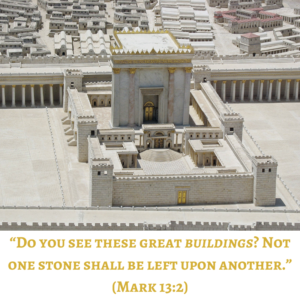
The Olivet Discourse (Matt 24–25; Mark 13; Luke 21:5–38) determines biblical prophecy. If we misunderstand it, we will distort “the gospel of the kingdom” that is “a witness to all the nations” (Matt 24:14).
This distortion will affect our view of the Great Commission. Jesus said, “Go into all the world and preach the gospel to every creature” (Mark 16:15). Our goal is to “make disciples of all the nations” (Matt 28:19). Our view of the kingdom of God determines whether we believe this is even possible.
These links between the Olivet Discourse and much broader themes—the gospel, the kingdom of God, the Great Commission, etc.—explain my interest in Elder Michael Ivey’s essay on the Olivet Discourse. His work contradicts my views of that passage and, therefore, my prophetic framework (i.e., inmillennialism1). If his thesis is correct, my ideas about the Great Commission and the kingdom’s future in this age are wrong.
These observations prompted me to publish the essay and respond to it. Elder Ivey graciously granted permission for me to do so.
The essay has two key points. First, it claims that Jesus did not say the fulfillment of his prophecy would happen in his generation (cp. Matt 24:34); he said it would begin to happen. I responded to that claim here. Second, Elder Ivey divides the Olivet Discourse into two parts: (1) Matthew 24:15–22 “contain(s) the prophecy of the destruction of the Temple” and (2) Matthew 24:23–28 “denote(s) the sign and sureness of Christ’s second coming” in our future. I denied this division here.
In this post, I will consider the illustration Elder Ivey gives to support his interpretation.
The Western Wall Illustration
Elder Ivey says the Western (or Wailing) Wall in modern Jerusalem illustrates his “begin to be” interpretation. It shows, he says, that the Romans began to destroy the temple in AD 70 but did not finish. They left some stones in the wall undisturbed. Therefore, the temple’s destruction awaits the last day.
Elder Ivey puts this partial destruction into an “already—not yet” framework. God has already fulfilled some elements of Jesus’ prophecy but has not yet fulfilled others. He will finish the job in our future. Then “not one stone shall be left here upon another, that shall not be thrown down” (Matt 24:2), and not until then.
Elder Ivey makes a fundamental assumption: that the wall was part of the temple. He states this assumption in different ways, saying, “A portion of that Temple remains today” and referring to “the remains of the western wall of (the) Temple Mount.” The wall “is a preserved portion of the same Temple to which Jesus referred and its stones remain to this day.” Elder Ivey does not cite historical sources for these statements.
This assumption is wrong for at least two reasons. First, it ignores the wall’s chronology. The Jews built the Second Temple around 520 BC.2 It stood for five centuries without the wall under consideration. Herod the Great expanded the temple complex, starting around 20 BC. He built “a massive retaining wall … (including) the Western Wall, also known as the Wailing Wall.”3 When Herod died in 4 BC, the wall was unfinished. Workers were still building it when Jesus, in AD 30, foretold the temple’s destruction. The disciples would not have linked this prophecy to an incomplete retaining wall. Neither should we.
Second, this assumption ignores the precise language of Scripture. Let’s compare the object of Jesus’ prophecy in the three accounts of the Olivet Discourse. Matthew says, “Then Jesus went out and departed from the temple, and His disciples came up to show Him the buildings of the temple” (Matt 24:1). Mark says, “Jesus answered and said to him, ‘Do you see these great buildings? Not one stone shall be left upon another, that shall not be thrown down” (Mark 13:1–2). Luke says, “As some spoke of the temple, how it was adorned with beautiful stones and donations, He said, ‘These things which you see—the days will come in which not one stone shall be left upon another that shall not be thrown down’” (Luke 21:5–6). Jesus spoke of the stones in the temple buildings, not those in a wall still under construction.
Conclusion
I shuddered while reading one of Elder Ivey’s statements. He said, “If this prophecy was completely fulfilled in 70 A.D. … then Jesus misspoke.” But if the Lord “misspoke,” he was a false prophet! This alarming assertion rests on the false assumption that a retaining wall was part of the temple buildings.
Today’s Western Wall is not a remnant of the temple. It should not affect our understanding of Jesus’ prophecy in the Olivet Discourse.
We need a prophetic model that doesn’t force us to make statements like this. Or force us to divide the Olivet Discourse into artificial parts. Only then can we understand that God means for the kingdom’s gospel to “make disciples of all nations” in the present age.
I recommend inmillennialism.4
Footnotes
- I document this perspective in Michael A. Rogers, Inmillennialism: Redefining the Last Days (Tullahoma, TN: McGahan Publishing House, 2020). This book is available here in hardcopy and here as a PDF. A free summary PDF document of inmillennialism is here.
- John J. Pilch, A Cultural Handbook to the Bible (Eerdmans: Grand Rapids, MI; Cambridge, U.K., 2012), 74.
- Alan J. Hauser and Earl Kellett, “Temple, Herod’s,” ed. John D. Barry et al., The Lexham Bible Dictionary (Bellingham, WA: Lexham Press, 2016). Emphasis added.
- Rogers, Inmillennialism. This book is available here.

2 comments
Excellent point and well stated as always! Bless your work!
Thank you, Rick!